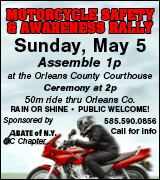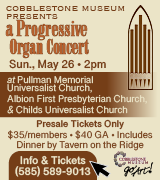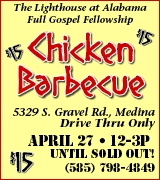Medina’s standards in historic district have worked to the envy of other small towns
Editor:
This is in response to the Form Foundation’s letter with their petition on Change.org.
The Foundation compares their first project to the Montreal Mural Festival and the Buffalo Albright Knox Public Art Program. They then state that their project should essentially have little or no oversight, guidelines or regulation. Neither of the previously mentioned programs operates that way.
Guidelines, standards, application processes and juried reviews are the norm in the art world. Only graffiti “artists” who unlawfully and without permission deface buildings, bridges, signs, rail cars, trucks and buses operate without regulation. They violate the law, deface and damage property. The cleanup cost to the taxpayers is high. There are much better ways to spend those funds.
The Foundation’s stated goal is to bring “Cultural Modernism” to Medina. The Foundation should consider the possibility that people come to Medina to get away from “Cultural Modernism” and return to a simple rural small town quiet way of life. They state that they want to “be present” and “garner outside social and economic interest” in the village. Again could it be that people come here and businesses locate here so that their employees can be present in a village that is free of cultural modernism and rich in the atmosphere of small town rural America.
The Planning Board and Zoning Board of Appeals operate under comprehensive New York State laws as well as within the detailed provisions of the law within their responsibility. The Village regulations for historic preservation are based on the State Historic Preservation Office model and were reviewed and approved by that office before they were adopted. Application reviews and decisions of the Planning and Zoning Boards are made under strict provisions of New York State law. Decisions are required by law to be based on findings of fact in the matter being reviewed.
What the Foundation sees as “overly bureaucratic” is how the State of New York protects people such as them and ensures that local boards are not arbitrary, capricious, myopic or whimsical. Medina’s boards are extremely well trained and have long been recognized by their peers and by applicants before them as being fair, comprehensive, detail oriented, helpful and highly professional.
As Code Enforcement Officer I have, on numerous occasions, had applicants for projects large and small tell me what a pleasure it was to work with the Planning and Zoning Boards. They comment that our local laws and regulations, by being comprehensive and detailed, make their job as applicants easy. They know going into the review what is required in detail, making for a quick and simple approval process.
Likewise, code enforcement in the village has for the past 20 plus years set very high standards. Scores of violations of the New York State Property Maintenance Code, The New York State Fire Code, Village Code and Zoning Regulations have been cited each and every year. Are we perfect, of course not. Code enforcement is by its very nature an ongoing process constantly striving to maintain a level of compliance that is realistic and attainable for the local conditions and economics. As those factors improve, incidence and compliance improves to the next level.
Again, the Village of Medina program has been recognized for years throughout Western New York for being professional, fair, knowledgeable, and helpful. The Foundation however found code enforcement in the village lacking. When they violated the law it was followed by enforcement action and violation notices as required.
Historic preservation and careful accurate restoration of buildings and structures can be a long, expensive and frustrating process. The majority of people involved in it realize that it is well worth it. They do it because they love the buildings and realize the value and rewards in preserving our architectural history.
In the process surprises, sometimes unpleasant, are to be expected. Costs often soar and the time to completion expands. This is especially true of individuals with limited funds often doing most of the work themselves while being dedicated to a perfect finished result. There is no set formula or time limit.
Medina, despite what the Foundation thinks, is firmly in the 21st century. We have capitalized on our rich store of historical assets and charming small town atmosphere to attract new residents as well as new business and jobs. Existing businesses have expanded. The occupancy level in the Central Business and Historic Preservation District is fantastic. Streetscapes and infrastructure have been improved. Millions of dollars have been invested. Medina is a shopping, dining and history visitor destination.
Medina is a premier Erie Canal village. People come in great numbers from Rochester, Buffalo and far beyond for all these reasons and some they don’t fully understand. They come because in some intangible way it just feels right and good. It is the America they imagine and remember, free from the cares and distractions of modern life. Newspaper and magazine articles, online articles, visitor guides economic impacts and visitation numbers bear this out. It is not about “cultural modernism” in which you can be submerged in any urban and suburban area. It is about the small town of your memory and imagination right here to bring you peace and enjoyment.
The Form Foundation could have pursued a goal of public art in Medina in an inclusive, orderly and open manner. They could have sought out the appropriate officials and boards to discuss a way to move forward in an acceptable and legal manner. This is how civic matters and business is conducted.
Instead they consciously and deliberately chose a path of confrontation. They did as they pleased, ran afoul of the law, then proclaimed shock, frustration and dismay at the reaction they provoked. In my opinion, it was calculated from the beginning to play out just this way as a means to present themselves as innocent folks abused by bloated government and to garner attention and sympathy to advance their plan.
In closing let me say that I believe Medina has a great future. All the key elements are in place. It is ours to build successfully or foolishly squander. Is public art a part of that future, it could be and I hope that it is. That said, if a cartoon alligator waving a Buffalo Bills pennant in the Historic Preservation District is the best we have for a first effort, it is over before it starts. I sincerely hope the Form Foundation can step back, evaluate and reconsider their plan, presentation and rhetoric and become a serious, inclusive and valued contributor.
Martin Busch
Middleport
Busch is the recently retired code enforcement officer for Medina.











































































